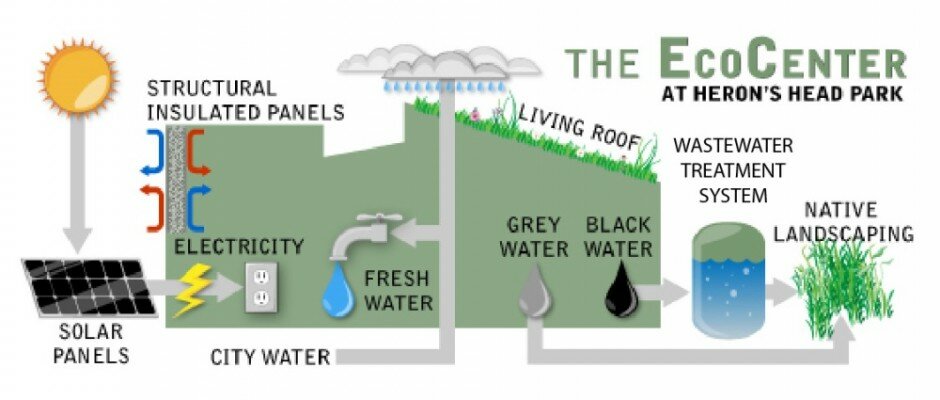The EcoCenter represents one of San Francisco’s best examples of sustainable solutions to adverse human impacts on the environment. On‐site energy generation and water conservation and management strategies reduce input from, and output to, San Francisco’s electrical grid and sewage systems. In fact, the building has no connection to the City’s storm and wastewater treatment systems. All water that falls on the site is managed through an array of low-impact design features including a living roof, rainwater harvesting, on‐site wastewater treatment (including a constructed wetland), native landscaping, and permeable paving. The EcoCenter also features sustainable building materials incorporating as many reused and recycled materials as possible, along with energy and resource efficient devices and fixtures. In July 2013, the EcoCenter was certified by the United States Green Building Council (USGBC) as a Leadership in Energy and Environmental Design (LEED) Platinum building. It is the first LEED Platinum – Zero Net Energy Building in San Francisco and the first LEED certified building in Bayview Hunters Point (BVHP).
The EcoCenter was designed by Toby Long Design and was a collaborative project between Literacy for Environmental Justice (LEJ), the Port of San Francisco, the San Francisco Department of the Environment, and the California Coastal Conservancy. Below is an overview of the building’s sustainable design features. Click on the headings to learn even more.
“Off-the-Grid” Solar Photovoltaic Energy System
The EcoCenter is the first and only environmental education center in San Francisco that is “off-the-grid.” The “grid” refers to the network of electric power plants and transmission lines that deliver electricity to most homes and businesses. The EcoCenter produces and stores its own electrical energy via 24 solar photovoltaic (PV) panels (producing 4.6 kilowatts of power) and a storage battery bank that provides power during periods of low or no sunlight. All electrical wiring conduits inside the facility are exposed to inform visitors of the sources and pathways of electricity from the rooftop through the building to the devices and fixtures it powers.
Living Roof
Covered with native plants, the EcoCenter’s living (or green) roof absorbs rainwater, thus reducing stormwater runoff from the building that could cause erosion. The living roof also restores habitat for wildlife, prolongs the life of the roof, provides insulation to the building’s interior, and helps reduce the urban heat island effect. The term urban heat island refers to the phenomenon that built-up areas tend to be hotter than nearby rural and natural areas.
Rainwater Harvesting System
Rainwater harvesting is the practice of collecting and using rainwater for various non-consumptive purposes such as watering plants or flushing toilets. The EcoCenter captures rainwater that falls on the roof in three 4,800‐gallon tanks. These tanks supply water to the living roof and surrounding native landscaping and will one day provide water to the toilets —saving thousands of gallons per year of potable water from the Hetch Hetchy Reservoir —the major water source for San Francisco.
On-Site Wastewater Treatment System with Constructed Wetland
The EcoCenter is the first facility and one of only two buildings in San Francisco that treats all of its own wastewater —both grey and black — onsite! Greywater is water from our bathroom sinks, showers, bathtubs, and washing machines. Blackwater is water and solids from our toilets and kitchen sinks. Going beyond conventional wastewater treatment, the processes at the EcoCenter involve irradiation of effluent (treated water) and incorporation of a constructed wetland with aquatic mesocosms (water enclosures meant to mimic freshwater ponds) to further consume and sequester nutrients, organic matter, and other potentially harmful substances. Treated water ultimately reaches the drainfield where there is a butterfly meadow.
Native Only Landscaping
Only Bay Area native plants are used in the landscaping and living roof at the EcoCenter. Because native plants have evolved in our region over thousands to millions of years, they are adapted to the climate, geography and organisms native to our area. They therefore require less water and are used to local soils. Native landscaping also provides needed food and/or habitat to local species. Natives that are perennials have deeper root systems that help reduce erosion and can out-compete invasive plant species such as the annual grasses pervasive in the City. As described above, plants on the living roof and surrounding landscaping are watered predominantly using harvested rainwater, while the butterfly meadow is maintained by treated effluent.
All pathways and paving around the EcoCenter are made of permeable materials that permit the movement of stormwater through its surfaces into the ground below. This is especially important at the EcoCenter since there is no tie-in to the City’s sewer system. All water that falls on the site is either captured or made to infiltrate into the ground. In addition to reducing runoff that could lead to erosion, porous surfaces can improve water quality by filtering and trapping pollutants in its sublayers.
Sustainable Building Materials and Other Resource Efficient Design Features
The EcoCenter was created using an extensive array of sustainably harvested, sourced, reused, and recycled materials, as well as energy- and resource-efficient design features and fixtures. These include structurally insulated panels (SIPs) made with Forest Stewardship Council (FSC)-certified wood and recycled polystyrene foam insulation, FSC-certified wood throughout the buildings’ interiors, reclaimed wood exteriors, concrete foundation and flooring made with 100% recycled aggregate and 75% slag, windows with recycled glass content, window frames made of a reclaimed wood/partially recycled plastic composite that never needs painting, reused cabinetry, interior doors, moldings and furniture, recycled glass countertops, a Trombe wall (a passive solar heating design), highly efficient LED (light-emitting diode) light fixtures, daylighting (i.e., predominantly natural lighting during the daytime), solar thermal and radiant floor heating, low-flow faucets and toilets, and no- or low-VOC (volatile organic carbon) paints, sealants, and adhesives.
Download a pdf file with an overview of the EcoCenter’s sustainable design features.




